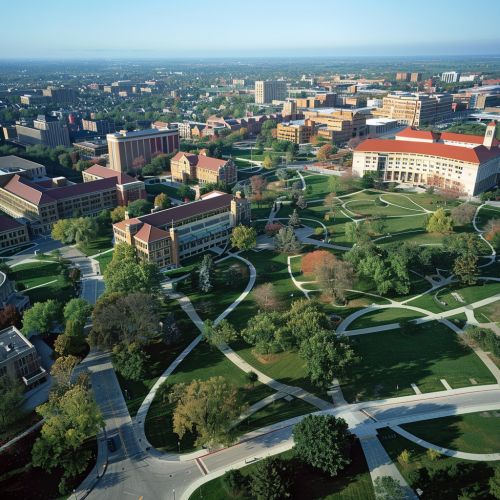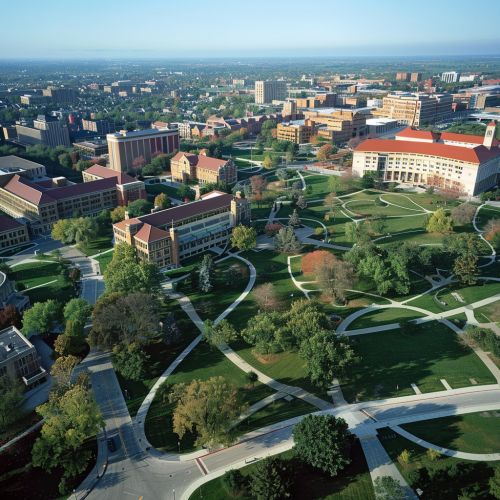University of Nebraska-Lincoln: Difference between revisions
(Created page with "== History == The University of Nebraska-Lincoln (UNL), founded in 1869, is a public research university located in Lincoln, Nebraska. It is the flagship institution of the University of Nebraska system and a member of the Big Ten Conference. The university was established under the Morrill Act of 1862, which provided land grants to states to finance the establishment of colleges specializing in agriculture and the mechanic arts. Over the years, UNL has grown into a comp...") |
No edit summary |
||
| Line 5: | Line 5: | ||
The UNL campus is divided into two main areas: City Campus and East Campus. City Campus houses most of the academic buildings, administrative offices, and student housing, while East Campus is home to the College of Agricultural Sciences and Natural Resources, as well as the Nebraska East Union and various research facilities. | The UNL campus is divided into two main areas: City Campus and East Campus. City Campus houses most of the academic buildings, administrative offices, and student housing, while East Campus is home to the College of Agricultural Sciences and Natural Resources, as well as the Nebraska East Union and various research facilities. | ||
[[Image:Detail-97409.jpg|thumb|center|Aerial view of the University of Nebraska-Lincoln campus, showing academic buildings, green spaces, and pathways.|class=only_on_mobile]] | |||
[[Image:Detail-97410.jpg|thumb|center|Aerial view of the University of Nebraska-Lincoln campus, showing academic buildings, green spaces, and pathways.|class=only_on_desktop]] | |||
=== City Campus === | === City Campus === | ||
Latest revision as of 01:45, 30 July 2024
History
The University of Nebraska-Lincoln (UNL), founded in 1869, is a public research university located in Lincoln, Nebraska. It is the flagship institution of the University of Nebraska system and a member of the Big Ten Conference. The university was established under the Morrill Act of 1862, which provided land grants to states to finance the establishment of colleges specializing in agriculture and the mechanic arts. Over the years, UNL has grown into a comprehensive institution offering a wide range of undergraduate, graduate, and professional programs.
Campus
The UNL campus is divided into two main areas: City Campus and East Campus. City Campus houses most of the academic buildings, administrative offices, and student housing, while East Campus is home to the College of Agricultural Sciences and Natural Resources, as well as the Nebraska East Union and various research facilities.


City Campus
City Campus is the heart of UNL, featuring iconic buildings such as Love Library, Memorial Stadium, and the Nebraska Union. The campus is designed to foster a vibrant academic and social environment, with numerous lecture halls, laboratories, and recreational facilities.
East Campus
East Campus is primarily focused on agricultural and natural resources education and research. Key facilities include the East Campus Union, the Dairy Store, and the Larsen Tractor Test & Power Museum. The campus also features extensive green spaces, including the Maxwell Arboretum.
Academics
UNL offers a diverse array of academic programs through its ten colleges, which include:
- College of Agricultural Sciences and Natural Resources
- College of Architecture
- College of Arts and Sciences
- College of Business
- College of Education and Human Sciences
- College of Engineering
- Hixson-Lied College of Fine and Performing Arts
- College of Journalism and Mass Communications
- College of Law
- College of Public Affairs and Community Service
Research
UNL is classified as an R1: Doctoral Universities – Very high research activity by the Carnegie Classification of Institutions of Higher Education. The university is involved in numerous research initiatives, including the Nebraska Center for Materials and Nanoscience, the Nebraska Public Policy Center, and the Center for Brain, Biology, and Behavior.
Student Life
UNL offers a rich student life experience, with over 500 student organizations, including academic clubs, cultural groups, and recreational sports teams. The university also hosts various events throughout the year, such as the Homecoming celebration, the Big Red Welcome, and the Lied Center for Performing Arts performances.
Housing
The university provides a range of housing options, including traditional residence halls, suite-style living, and apartment-style accommodations. Notable residence halls include Abel Hall, Sandoz Hall, and the Courtyards.
Athletics
UNL's athletic teams, known as the Nebraska Cornhuskers, compete in the Big Ten Conference. The university has a storied athletic tradition, particularly in football, where the Cornhuskers have won multiple national championships. Memorial Stadium, the home of Nebraska football, is known for its sellout streak, which began in 1962.
Notable Alumni
UNL has produced numerous notable alumni who have made significant contributions in various fields. Some of the distinguished alumni include:
- Warren Buffett, CEO of Berkshire Hathaway
- Ted Sorensen, speechwriter and advisor to President John F. Kennedy
- Johnny Carson, television host and comedian
- Willa Cather, Pulitzer Prize-winning author
See Also
- Morrill Act
- Big Ten Conference
- Carnegie Classification of Institutions of Higher Education
- Land-grant university
